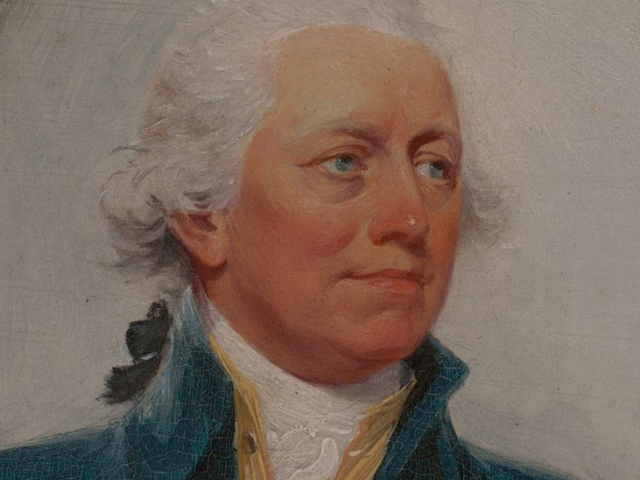
Portrait of Ralph Izard. 1793. Painted by John Trumbull. Wikimedia Commons.
(1742-1804) Izard was the son of Henry Izard and Margaret Johnson. At the age of twelve, Izard traveled to England, where he first attended Hackney School and later matriculated at Christ College, Cambridge University, in 1761. Returning to South Carolina in December 1764, Izard inherited extensive property in three lowcountry parishes. He established his home plantation at the Elms, St. James Goose Creek Parish, and built up a beautifully landscaped estate that eventually comprised 2,353 acres. While traveling in New York, Izard met Alice DeLancey, whom he wed on May 1, 1767. The marriage produced fourteen children, seven of whom reached maturity.
In his early years, Izard preferred the life of a cultivated gentleman and did not pursue politics. The Izards moved to London in 1771 and planned to reside in England permanently and live off the income of their South Carolina estates. But the political break between Britain and the American colonies forced the family to move to Paris in 1776.
Izard’s presence in Europe made him available for diplomatic service. In May 1777 the Continental Congress elected him commissioner to Tuscany. Because the grand duke of Florence refused to allow representatives of the rebellious colonies into Italy, Izard never made it to Tuscany. He spent the next two years in Paris corresponding with Tuscan officials and becoming entangled in the disputes that divided the official American commissioners in France. Izard developed a particular antipathy toward Benjamin Franklin, which would endure throughout his public career. Frustrated over his status as a diplomat in waiting, Izard resigned in March 1779. Shortly thereafter, Congress recalled him in June 1779 because of his fractured relationship with Franklin and allegations of financial misconduct. On his arrival in Philadelphia in August 1780, Izard explained to Congress the difficulties under which he had operated.
Congress responded by exonerating him. Before returning to South Carolina, Izard visited General George Washington’s headquarters and successfully lobbied for the appointment of Nathanael Greene as commander of the Continental army in the Southern Department.
In January 1782 the South Carolina legislature elected Izard to the Continental Congress, where he served until September 1783. With the war’s end, Izard set out to rebuild his damaged property in South Carolina. He succeeded in recouping his losses and by 1790 owned 602 slaves, becoming one of the wealthiest planters of his day. Earlier than most of his contemporaries, Izard envisioned canals as a means of developing the South Carolina backcountry and cementing that region’s political ties to the lowcountry. He helped establish the Santee Canal Company in 1786.
Around this time Izard also acquired two politically prominent sons-in-laws, Gabriel Manigault and William Loughton Smith. Together they formed the Izard-Manigault-Smith, or Goose Creek, faction and played a major role in South Carolina politics for more than a decade. Elected to the state House of Representatives five times between 1782 and 1789, Izard emerged as a “planter-boss of the lowcountry.” In December 1786 he exerted his political influence to prevent the election of Thomas Tudor Tucker to the state legislature, resulting in a duel in which Izard shot his opponent in the left thigh. In 1788 Izard helped ensure his son-in-law William Smith’s election to the U.S. House of Representatives by authoring Another Elector for Charleston District, a broadside that labeled Smith’s opponent, David Ramsay, as antislavery and inimical to South Carolina’s economic interests.
Izard soon joined his son-in-law in Congress. In January 1789 the South Carolina legislature elected Izard to the U.S. Senate. In the First Congress, he united with other Carolina congressmen in lobbying for federal assumption of state debts, a policy that relieved South Carolina of a crippling financial burden imposed by the war. He opposed passage of the Bill of Rights and strongly objected to the reception of Quaker antislavery petitions. Izard generally supported the Washington administration, though he firmly opposed any executive encroachment on the Senate’s prerogatives. Izard served as president pro tempore of the Third Congress from May 1794 to February 1795. At the conclusion of his term, he retired to South Carolina to manage his plantations. In 1797, Izard suffered a stroke that left him an invalid. He died in Charleston and was buried in the St. James Goose Creek Churchyard.


